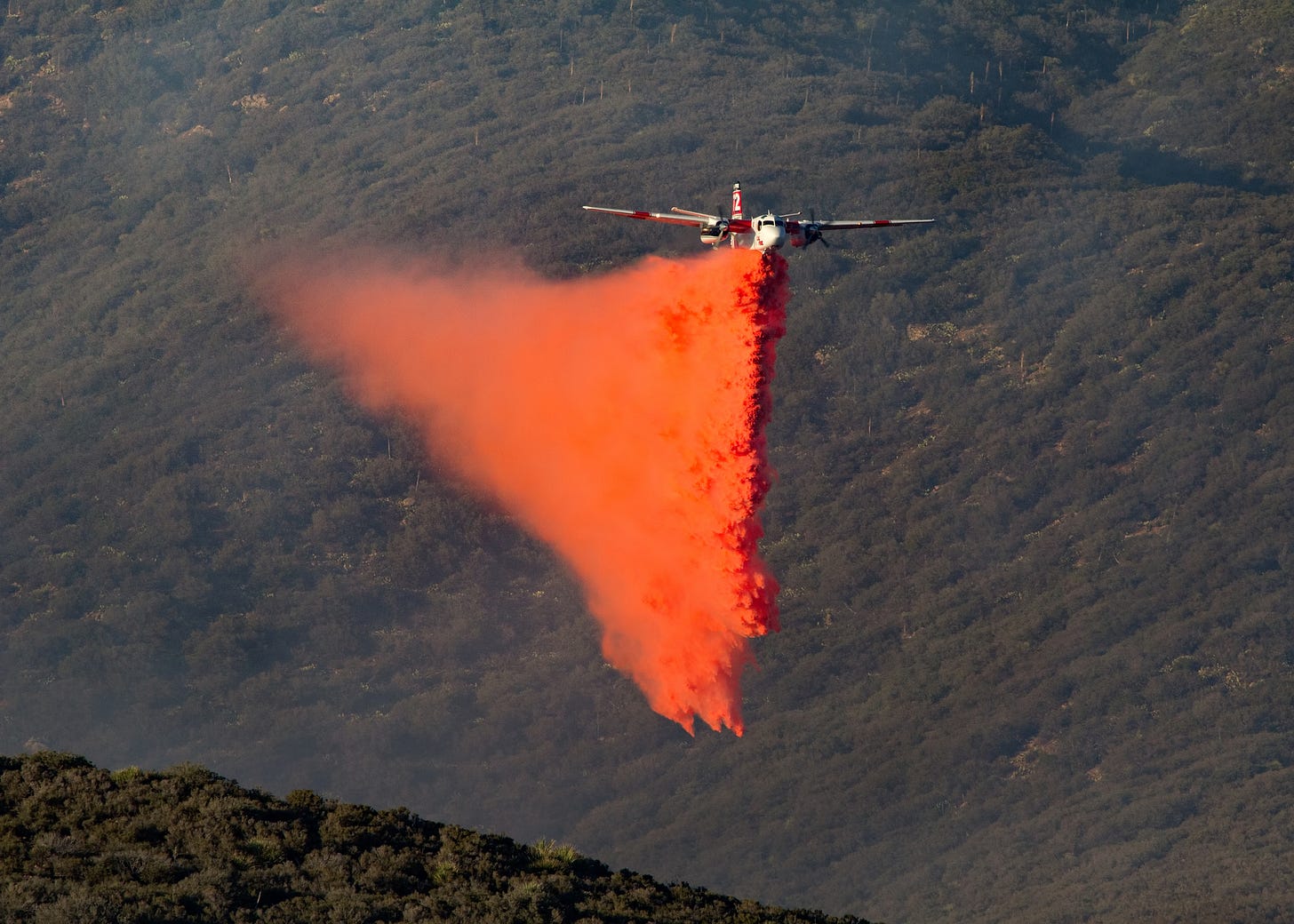Is Fire Retardant Causing Hotter, more Volatile Wildfires?
A Deep Dive into the effects of "slurry," the commonly used fire retardant.
I remember the first time I encountered slurry on a fire. I was working as a hotshot and we were right up against the flank of a fire in Southern California. My ears were stuffed with small orange foam earplugs to protect my hearing from the high pitched drone and whirring of chainsaws, which surrounded me. I could hear myself breathing and feel the contact of my pulaski against the ground with each swing of my tool. We were exposed on a hillside, digging sidehill, the ground slipping out from beneath our Vibram-soled leather boots with each step we took. Dried oak leaves increased the slipperiness of the ground’s surface. We’d hiked a while to get here, and the t-shirt under my Nomex, already stained with sweat, was sopping wet. Occasionally I reached up and grabbed the nozzle of my Camelbak, which snaked out from my line pack, and sipped.
Someone yelled something indiscernible. Usually the folks with radio monitored the Air Attack channel, but maybe someone somewhere had dropped a ball, and I looked up to see a giant tanker heading our way. We shuffled back from the fire line, but there wasn’t really anywhere to go. My gut dropped into my shoes. The bottom of the tanker opened above us and released thousands of pounds of red goo.
We were lucky that we caught the first portion of the drop and not the middle portion, which spread above us along the edge of the green in order to slow the uphill climb of the fire. My red hard hat was covered with goo, my yellow Nomex shirt now pink, and wet. I’d been told that fire retardant was made of fertilizer. Truthfully, I didn’t know what was in it. That wasn’t my top concern.
I’m guessing that California uses fire retardant more than anywhere else— Cal Fire has abundant air attack, helicopters and fixed wing aircraft. The use of fire retardant has increased over the years, along with an increase of urban dwellings in more rural areas. But what exactly is the impact of retardant, in California and elsewhere?
“The retardant, called Phos-Chek, contains ammonium phosphate, a fertilizer. It also includes chemicals to regulate how the slurry drops, emulsifiers that render it gooey so it sticks to targets, and a coloring agent so air crews can track what they’ve dropped. For the most part, the ingredients are disclosed to Cal Fire by the Phos-Chekmanufacturer, ICL-Performance Products, LP.
But the entire formula is not made public. George Matousek, an ICL chemist who helped formulate the retardant, said the precise recipe is a trade secret but ‘all products in Phos-Chek are food-grade or better.’
The chemicals are mixed with water and are generally harmless to humans and most animals, according to the company. But retardants are known to be toxic to fish, so state and national fire-fighting agencies prohibit drops within 300 feet of water sources.
But as Western wildfires increasingly move out of forests and into developed areas, firefighters have less wiggle room to target their drops.
When a converted 747 jetliner is lining up to release nearly 20,000 gallons of retardant, there’s no guarantee of precision. Pilots are often guided away from water sources and landscapes containing plants that are endangered or otherwise protected by law, using retardant avoidance maps published by the U.S. Forest Service.
It’s an issue that’s taken seriously by fire-fighting agencies. Biologists say that a sudden dump of nutrients in soils can encourage the growth of non-native or invasive plants.” -KQED
Keep reading with a 7-day free trial
Subscribe to WILDERNESS to keep reading this post and get 7 days of free access to the full post archives.



